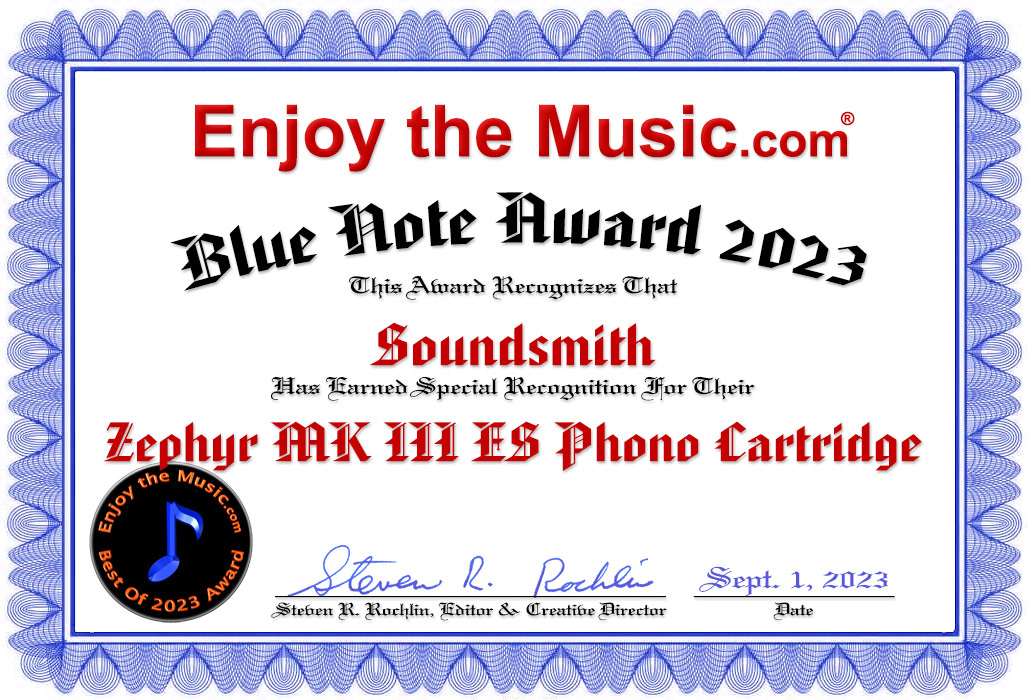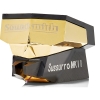Soundsmith The Voice Ebony Cartridge Review

"The Voice ... is without a doubt the best non-moving coil cartridge I have heard and I would rank it in the top five of any cartridges I have ever heard."
- Jack Roberts, Dagogo
History and Description
At the 2008 Rocky Mountain Audiofest I was impressed by the fact that several systems that were all-out assaults on the state-of-the-art were using a non moving-coil cartridge from Soundsmith. The cartridge was a moving iron design called “The Voice.” It is based on the much underrated and one of my favorite cartridges from the past, the B&O MMC1. One of the first phono cartridges I ever owned was a B&O SP12, and then later the MMC1.
Anyway, back to the RMAF, I eventually made my way down to the Soundsmith room where I had the privilege of visiting with the slightly larger-than-live Peter Ledermann. Peter was a joy to meet and the sound in his room was great. He promised to send me “The Voice” to review. Shortly after the show he emailed me to say he was working on some small improvements to the cartridge, so it turned out I didn’t receive my review sample until March. Such are the perils of getting something from a perfectionist like Peter.
If you don’t know who Soundsmith is, that’s no surprise, but you need to. Soundsmith is Peter Ledermann’s company located in Peekskill, New York. Peter has a pretty interesting background. He had been a design and production engineer at RAM Audio with Richard Majestic at the helm, and was director of engineering for the legendary Bozak speaker company afterwards. After Bozak, he worked at the prestigious T.J. Watson IBM Research center in Yorktown New York, one of IBM’s five “think tank” facilities. All during this period he operated The Soundsmith, an “audio mentoring” company. Since leaving IBM in 1991, he has devoted his full attention and time to Soundsmith.
During those 39 years, Peter has worked his magic through his company Soundsmith. He provides audio repairs for many major accounts in the New York, Connecticut, and New Jersey area, as well as equipment shipped to them from all over the world. The company does authorized warranty repair of products from Audio Research, Bang & Olufsen, DartZeel, Jeff Rowland, McIntosh and Revox. Peter is also quite renowned for retipping and rebuilding phono cartridges, as well as manufacturing B&O cartridges. These days, he is manufacturing his “Strain Gauge” phono cartridge systems and a fine line of moving iron phono cartridges, along with numerous and varied types of audio equipment, something he has done for many years.
The Voice comes in the standard acrylic body, and units from a special version in the ebony body are handpicked from the top 5% of production. The ebony version of The Voice was the one that I got for review. It uses a cantilever made from a single crystal ruby rod, and the stylus is his selected “Optimized Contour Contact Line Nude” diamond. Like I said above, “The Voice” is an evolution of the original B&O MMC1 moving iron cartridge that used what B&O referred to as an “moving-micro-cross (MMC). The new Soundsmith SMMC1 and “The Voice”, like all moving-iron designs, use stationary coils and magnets with a small piece of “moving iron.”
What makes this design different from the few other moving iron cartridges out there was that they used a cross-shaped piece of ultra-low-mass, high-purity iron that was attached to a soft elastomer stabilized damper. This iron cross also had a small tube in it where the cantilever was inserted. B&O said the advantage of this design was ultra-low moving mass, high output, and low vertical tracking forces. Today this is still true even compared to the best moving coil designs. On their website, Soundsmith says they want to overturn the myth that moving coil cartridges are the only path towards perfection.
Design Goals
Peter says the result of the 40-year evolution of this design is “The Voice”, with a lower effective moving mass than any moving coil designs, and 40% less moving mass than his other moving iron designs. This matters because lowering the moving mass makes it easier for the cartridge to control the stylus. He says because of this, the stylus can stay in better contact with the groove walls; if the stylus doesn’t stay in contact then you can’t hear everything on the record. Not only has the mass been lowered, it tracks at the unbelievable one gram. Theoretically that should mean less record wear and better sound quality, just like a sports car tracks the road better than any eighteen wheeler.
Most phono cartridges are designed around coils and magnets. With a moving magnet cartridge the coils are fixed in placed and the magnets vibrates as the stylus tracks the groove. A moving coil cartridge works just the opposite, and the advantage of the MC is that it is less massive, while the moving magnet cartridge has higher output. The Voice, like the London Reference, is neither a moving magnet or a moving coil; it is a moving iron design. With a moving iron, both the magnets and the coils are stationary and a tiny piece of metal moves between sets of fixed coils and fixed magnets. A Moving Iron cartridge has as little mass as most moving coils, and its output is high like the moving magnet design. Again, the cantilever of The Voice is made from a single high quality ruby and the stylus is what Soundsmith calls an “Optimized Contour Contact Line” nude diamond, selected for low noise. Compliance is very high at 28 µm/mN, though he also makes a medium version at 22 for matching with heavier arms.
Setup and Installation
Installing The Voice was straightforward, although a little care was warranted as there was no stylus guard. (On the issue of the stylus guard, we later discovered that the stylus guard was sent to Jack along with the cartridge; he just neglected to install it. Our apology to Peter Ledermann and our readers for this oversight. -Ed.) I installed The Voice in a Clearaudio Satisfy Carbon Fiber tonearm mounted on a Clearaudio Anniversary Wood Reference turntable. I also used it in the wonderful DaVinci Grand Reference tonearm mounted both on my turntable and the DaVinci InUnison turtable. In both cases I played it through the moving magnet stage of my Shindo Masseto and the wonderful Aesthetix Io Sig MkII phono preamp. When using with the DaVinciAudio Grand Reference, which has adjustable VTA during play, The Voice was an easy cartridge to set up. It was also easy to find the correct VTA on The Voice with the Clearaudio Satisfy tonearm.
The Voice was a very lightweight, high compliance cartridge that required a very low tracking force. At least it seems very low in this day and age, but if memory serves me right I remember owning an XLM that tracked around .5 grams. Since The Voice is built from B&O’s designed that was originally designed for B&O’s own very low-mass tonearms, I was concerned about The Voice’s compatibility with medium-mass arms like my Clearaudio or the DaVinci Grand Reference. My concerns seemed to have been unwarranted, as the cartridge preformed like a champ in both tonearms.
Lastly, Soundsmith’s recommended capacitive loading of 400pF did work best for me. This was easy to do with the Aesthetix Io Sig MkII phono preamp and sounded great. It was not easy to do with my Shindo Masseto, and while The Voice sounded good straight into the Masseto, it sounded its best when loaded at 400pF into the Aesthetix, so that’s the preamp I used for the review.
Listening
Of course, the whole point of a cartridge is to listen to music and I’m glad to say that The Voice sounded really good right out of the box. It did improve some with break-in but after about 50 hours, it seemed completely broken in to me. The Voice has an effortless sound that emerges out of a very quiet and black background. The basic sound of The Voice is bold, vibrant, has great scale, as well as a really nice soundstage.
I found the top-end extension and the midrange with The Voice in my system to be very nicely balanced, neither too warm nor too cold. The midrange of The Voice was very authoritative with an immediacy that reminded me of what people used to love about the old B&O cartridges. This is partially true because when it comes to tracking, The Voice is about as quiet and articulate as any cartridge I have ever heard. It managed to get out of the way and let me enjoy the music.
With The Voice in my system the bass was never too lean or even the least bit bloated. It was deep, quick, with great attack. It was very good with decay, but not quite up to the standards of the Miyabi Standard or Benz TR here. Still, I would rank the bass in my system with The Voice in the top five front-ends I have heard and better than either the Audio Note Sig 5 DAC or the Ypsilon DAC, both are part of digital systems I reviewed that cost over $50,000.(Up goes my blood pressure. –Ed.)
The Voice is as transparent as any cartridge I have heard. It can be very smooth at times and unexpectedly explosive at others, depending entirely on what you have placed on the platter for it to play. I must also mention just how extraordinarily quiet The Voice is. This quietness lets the sound come into your room in such an effortless way, and it never seemed to exaggerate surface noise.
I found the soundstage to be exemplary. It was plenty wide and deep, yet able to present a holistic soundfield that was truly three-dimensional. I found The Voice capable of allowing my system to present a very musical and realistic soundstage.
A Few Specific Examples
“Swing Low Sweet Chariot” and “Amazing Grace” from Joan Baez’s album, From Every Stage, are two songs I always use for evaluation in every review I write. With The Voice it was easy to hear the people in the crowd and the nuances in Baez’s voice. The Voice produced a sound in my system that was incredibly immediate, and alive sounding. It did all this as well as having a very coherent soundstage. Add to all this is the fact that it tracked these difficult inner grove cuts better than I have ever heard.
The musical Evita is one of my wife’s favorites, and I have to admit I find it to be a wonderful musical experience on vinyl that never quite worked for me on redbook CDs. On the opening of side four, there is a children’s choir. These delicate voices need to be reproduced with clarity, and with beautiful harmonics. The Voice is second only to the Benz TR in getting the delicacies of these voices correct. Both cartridges allow them to sound so real they’ll make you want to cry.
Ry Cooder’s great album Jazz is another LP I use in nearly every review. It’s the kind of album that highlights a system’s speed and delicacies. The Voice did a good job of falling right in the middle of these two sounds. Yes the Benz TR is more delicate and sweeter while the Miyabi Standard is faster and more alive sounding. The Voice falls straight into the middle of these two and strikes a great balance on this album.
I also find listening to Bob Dylan’s Nashville Skyline album very useful for evaluating equipment. There’s a cut where Bob Dylan and Johnny Cash sing “Girl from the North County”; these two men are both great folk singers, yet so different in voice and technique. This is why the song is so great for evaluation. The Voice did an excellent job of letting me hear the power in Cash’s voice as well as the gravel in Dylan’s voice. It also allowed the emotion in both of their voices to come through.
Conclusion
There’s something so alive sounding about a good moving coil cartridge. On the other hand, good moving magnet and moving iron cartridges like a Shure or Grado sound so correct and are also great trackers. The Voices comes closer than any cartridge I have ever heard at doing both. It is without a doubt the best non-moving coil cartridge I have heard and I would rank it in the top five of any cartridges I have ever heard.
Addendum
As it turns out The Voice that I reviewed was Soundsmith’s special-order 400 pf version, which allows more flexibility of top-end control on the part of the user, depending on capacitive load. The default manufacture’s load is a normal 200 pf load which should work wonderfully with most phono preamps. Anyway the good news is that you have a choice when you order yours.









